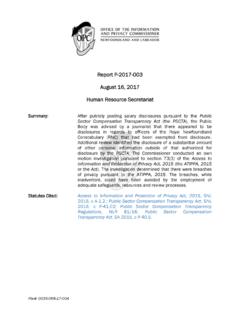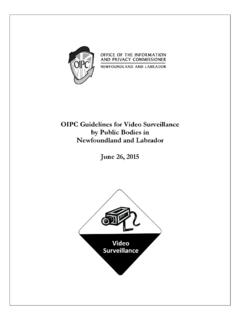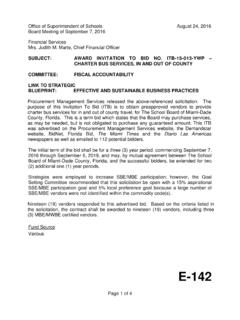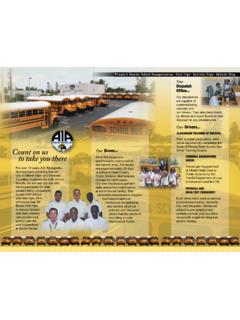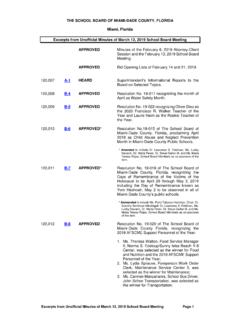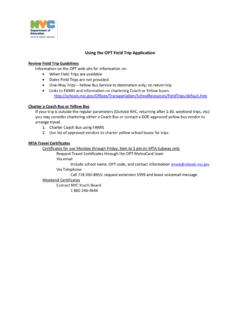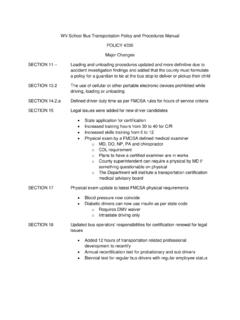Transcription of The Use of Video Surveillance in Schools and on School Buses
1 The Use of Video Surveillance in Schools and on School Buses Newfoundland and Labrador English School District December 6, 2018 Table of Contents Page # Commissioner s Message .. 1 Executive Summary .. 3 Introduction .. 6 Audit Objectives .. 6 Audit Focus .. 7 Overview of Video Surveillance .. 7 ATIPPA, 2015 .. 8 Video Surveillance and Schools in Newfoundland and Labrador .. 8 What is the Identified Purpose for the Collection? .. 9 Authority to Collect District s Submission .. 13 The Case Law .. 17 OIPC Review .. 18 New Builds .. 19 Notification .. 22 Protection of Personal Information .. 24 Administrative Safeguards .. 24 Technical Safeguards .. 26 Video Surveillance on Buses .. 28 Observations and Recommendations .. 30 Identified Purpose for the Collection .. 30 Authority to Collect .. 32 Notification .. 33 Protection of Personal Information.
2 34 Video Surveillance on Buses .. 37 Conclusion .. 38 Use of Video Surveillance December 6, 2018 1 Commissioner s Message The Access to Information and Protection of Privacy Act, 2015 (ATIPPA, 2015) limits the capacity of public bodies to collect and use personal information in order to ensure the public s right to privacy. Privacy is a right that is recognized by the Supreme Court of Canada and is protected by the Canadian Charter of Rights and Freedoms. Video Surveillance has long been a topic of interest for this Office, with guidance pieces on the topic dating back to 2013. Video Surveillance is becoming more and more prevalent in today s society and continues to erode our privacy.
3 Many have become desensitized to its presence, assuming that someone is always watching or recording what we do. The implications of constant Surveillance , especially ubiquitous Surveillance of our children, are deserving of further research. The foundations for acquiescence to omnipresent Video Surveillance include the opinions of those who hold the view that, if you are not doing anything wrong, why should you care. Beyond failing to recognize our constitutional right to privacy, this attitude fails to recognize that with advances in facial recognition technology, our participation in any event will be identifiable. Who decides what is wrong in the face of the new reality that simply participating in a lawful protest or attending a political event might negatively impact your future prospects for employment, government assistance or other benefits.
4 The issue, in the context of Schools , emerged into the spotlight in May 2017 when a media outlet reported the live streaming on a Russian website from Video Surveillance cameras installed in a School in Nova Scotia. Closer to home, the provincial NL Master Specification Guide for Public Funded Buildings, including Schools , include CCTV capabilities. While it might make financial sense to pre-wire for potential future installation of CCTV or install CCTV systems during the construction of a building, doing so presents challenges for privacy. The Master Specifications do not appear to consider the ATIPPA, 2015 when making decisions about Surveillance systems and, in the case of new Schools , accountability for ATIPPA, 2015 compliance rests with the District. Newly constructed buildings, including Schools , are being equipped with large numbers of cameras by default and many public bodies are using the cameras without a thought to their need or the requirement to evaluate whether their use accords with the ATIPPA, 2015.
5 It is important to note that with all cameras, not just the ones in newly constructed buildings, absent authority for the collection under the ATIPPA, 2015, public bodies collecting personal information using cameras are in fact breaking the law. Video Surveillance is not a tool that can be used in isolation and, in fact, research does not support Video Surveillance as a deterrent. Research does support the perception that Video Surveillance is a deterrent. While Surveillance footage may be useful in investigating Use of Video Surveillance December 6, 2018 2 incidents that have already occurred, the presence of the camera generally does not prevent the incidents in the first place.
6 This Office and the District are both committed to the creation of a safe and caring learning environment for students in our Schools . To protect students in Schools , Video Surveillance may have a role to play alongside other initiatives. While there are times that the use of Video Surveillance is justified, it should always be one of a number of alternative initiatives considered and/or implemented to address the issue at hand. During the course of this audit, for example, some Schools documented alternate activities extremely well, including an entire School community, including parents and students, being re-educated on behavioral expectations, and trained School prefects monitoring the School during the day. Less privacy-invasive options must always be considered and explored before resorting to Video Surveillance .
7 When cameras are used, the Act requires that a clearly defined purpose be identified. Evidence and documentation to support the need for Surveillance are required, including: specific incidents tied to each camera location to justify the use of each individual camera, and details of alternates considered and implemented prior to the camera use. Such documentation must be a living document, changing as needs arise and kept up to date. Anecdotal data is insufficient. Schools need to keep records of incidents of concern and track frequency before and after any preventative measures. We hope that the District will use this audit as an opportunity to continue its evaluation of currently installed Video Surveillance systems to ensure that it has the authority, under the ATIPPA, 2015, to collect personal information via every camera/system operating in its Schools .
8 The District is legally obligated to cease collecting personal information if camera use cannot be justified. Further, no new cameras/systems are permissible until the District assesses and documents them as necessary. We hope that students, parents and School associations will engage with the District in exploring the root causes of issues and the consideration of graduated responses to resolve problems that exist. The safety of students and staff is paramount. While Video Surveillance may sometimes be necessary to achieve that result, considerations must include interim responses that least impact privacy. Donovan Molloy, Information and Privacy Commissioner Newfoundland and Labrador Use of Video Surveillance December 6, 2018 3 Executive Summary The Office of the Information and Privacy Commissioner (OIPC) is an independent Office of the House of Assembly with oversight of the Access to Information and Protection of Privacy Act, 2015 (ATIPPA, 2015) and the Personal Health Information Act (PHIA).
9 Citizens expect the OIPC, as the oversight body, to assess the level of compliance with the law, to advocate for best practice and to assist public bodies in establishing effective privacy management programs. To assist in these efforts, the OIPC has developed an Audit and Compliance Program. Audits are conducted under the authority of section 95(1)(b) and section 95(3) of the ATIPPA, 2015. Section 95(1)(b) empowers the Commissioner to monitor and audit the practices and procedures employed by public bodies in carrying out their responsibilities and duties under this Act. Section 95(3) extends the Commissioner s investigative powers established elsewhere in Part IV to other activities, including audit. This is the third comprehensive audit undertaken by the OIPC. While past audits have focused on establishing the expectations of this Office with regard to specific aspects of the ATIPPA, 2015, the expectations of this Office regarding Video Surveillance in Schools are set out in our Guidelines for the Use of Video Surveillance Systems in Schools , released in February 2013.
10 After the release of this guidance document, a number of School boards in the province merged to form the Newfoundland and Labrador English School District (NLESD or the District) in September 2013. The purpose of this audit was to assess compliance with the ATIPPA, 2015 and the OIPC s guidance documents regarding Video Surveillance . The use of Video Surveillance by the District was identified as an audit topic because of the potential to impact a large number of individuals, with approximately 67,000 students and 8,000 staff. Video Surveillance also impacts the public as the cameras often capture anyone on or near School grounds within camera range. The NLESD issued a policy and affiliated procedures/regulations in 2014 that reflect the requirements of the ATIPPA, 2015 and the guidance on Video Surveillance issued by this Office.
